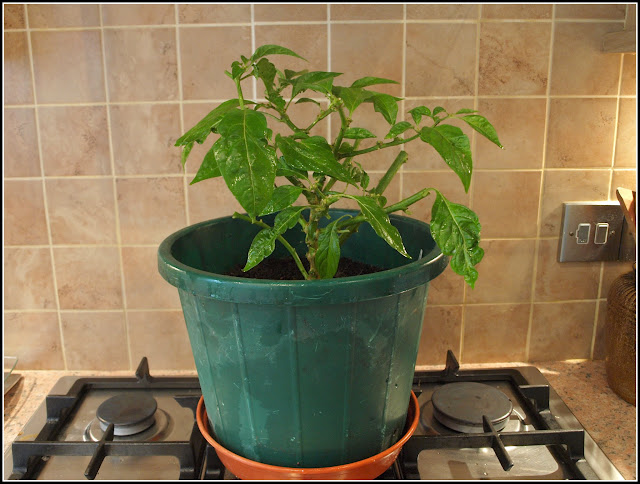 |
| Scotch Bonnet Caribbean Antillais |
I don't pretend to be a guru on this subject, but I'm going to explain the procedure I use, just in case you might want to copy it.
I start with a strong, healthy plant. A weak, sickly one is not worth bothering with. This one is my Scotch Bonnet Caribbean Antillais one. It has produced some attractive and fiery hot fruits this year and it seems like a perfect candidate for the treatment.
If we look closely at the plant, you can see that it has a strong woody main stem, and lots of branches.
Using sharp secateurs, I remove about two thirds of each mature branch, and I cut out completely any immature soft branches coming directly from the main stem. I also remove the majority of the big leaves. I want the plant to more-or-less go to sleep, and if it has too many big leaves it will be too vigorous.
Having done the pruning, I spray the plant very thoroughly with warm water to which I add a tiny drop of liquid hand soap. This is literally to wash the plant, removing any aphids and any fungal spores. I suppose that specialist Horticultural Soap would be best, but I haven't got any! Finally, I give the plant a good drink of water to help it get over the shock of its surgery.
The end result is a very compact plant, like this:
Now it goes onto the windowsill in the spare bedroom, and I hope for the best... During the Winter I will water it sparingly, without feeding it. If it pulls through I will start feeding it when the first signs of new growth appear. At that point I would probably re-pot it too, using fresh compost.
On a related theme: I have been doing a seed-viability test with some of the seeds I saved last year. I put a few seeds in some 4-inch pots, covered with plastic bags, and placed them in the airing-cupboard for a few days to see if anything would germinate. This one was from a packet labelled "Red Habanero 2014". They are definitely viable! I don't think I will be able to keep this little plant over the Winter, but it confirms for me that it will definitely be worth sowing some of those seeds in the Spring.
This is where those seeds came from - I think the variety is "Paper Lantern".
This year's chilli harvest is drawing to a close, but as you can see I'm already planning for next year's!







My chili overwintering experiment last year was over rather quickly when they were attacked by aphids. I didn't even both trying this year. Your method looks sound. Perhaps had I given them a good clean and pruned them back I would have had better luck.
ReplyDeleteOverwintering chillis is definitely worth a go if you get an earlier harvest the following year. Hope it works for you.
ReplyDeleteHot peppers are a favorite in our house, so I think overwintering them is a great idea! Thanks for the run through on how to. Our freezer still has plenty of frozen peppers from 2014.
ReplyDeleteI wonder whether you could do the same thing with sweet peppers?
ReplyDeleteI don't see why not. They are very closely related, after all.
DeleteI have been experimenting much like you have with overwintering the hot peppers. This year I dug a couple of them from the garden and potted them up. Even with our warm summers it is nice to get a jump on the season!
ReplyDeleteI am sceptic about your likely success.
ReplyDeleteBest of luck and make me eat my words Mark!